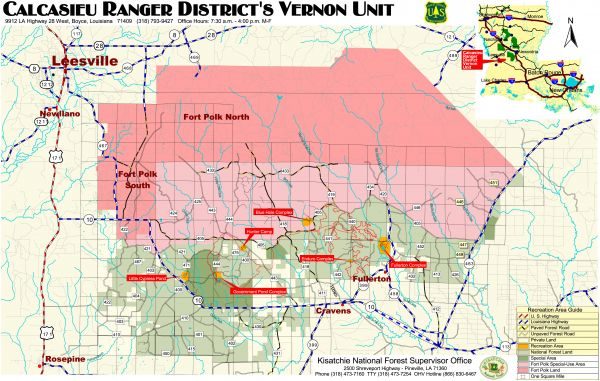
Kisatchie National Forest is a gem for Louisiana hunters and fishermen, one surprisingly little known beyond the Shreveport to Alexandria corridor where most of its lands lie.
The forest is huge, covering almost 604,000 acres. Because it is spread out into eight separate blocks, it is administered by five ranger districts.
And almost all of it is open to hunting and fishing.
The Calcasieu Ranger District (318-793-9427) headquartered in Boyce administers two separate units: Evangeline and Vernon, the latter of which was where Childress hunted.
The Vernon Unit comprises 85,000 acres, and is nestled next to Fort Polk, which itself adds another 105,545 acres of public hunting as a state wildlife management area.
Rules for the Vernon Unit and the Fort Polk Wildlife Management Area are virtually the same, with three exceptions. Fort Polk offers two small game only hunting areas, Castor 1 and Castor 2.
Also, portions of Fort Polk occasionally will be closed to hunting because of military maneuvers and training. Hunters are advised to check in with the Fort Polk Game Warden’s Office (337-531-5715) before traveling to the area to hunt. Six self-clearing check stations are located on Fort Polk WMA, with another five at nearby Peason Ridge WMA, also owned by the U.S. Army.
Finally, camping is prohibited on Fort Polk or Peason Ridge WMAs. Instead, hunters are advised to camp on nearby National Forest Service lands.
The Evangeline Unit just southwest of Alexandria is 97,000 acres and includes Kincaid Lake, a fishing destination. Like the Vernon Unit, it offers both piney uplands and hardwood bottoms.
To the north and west lies the Kisatchie Ranger District, which encompasses 102,000 acres. Within this unit are the 8,700-acre Kisatchie Hills Wilderness Area — which contains no roads or vehicle (including bicycle) access — and the 38,000-acre National Red Dirt Wildlife Management Preserve. Red Dirt is one of the most-rugged and scenic areas in the state, and has been called “Louisiana’s Grand Canyon.”
Free permits (available online or by calling 318-472-1840 or 318-765-3554) are required for use of Red Dirt Wildlife Management Preserve, as well as for the National Catahoula Wildlife Management Preserve located within the Catahoula Ranger District. Camping in both preserves is restricted to designated camping areas.
The Catahoula Ranger District administers a 121,500-acre block of land immediately north of Alexandria and almost completely surrounding the towns of Dry Prong and Bentley. Much of the southern end of this tract is fragmented into blocks of public and private land.
The Winn Ranger District comprises two blocks of land totaling 164,000 acres in Winn, Natchitoches and Grant parishes. Twenty-one miles of beautiful Saline Bayou, a National Wild and Scenic River, meander through the district.
Farthest north is the Caney Ranger District. Its 32,000 acres are broken into three units: Caney Lakes Unit, Middle Fork Unit and Corney Lake Unit. This district is best known for its fishing, with six of the state’s 10 biggest largemouth bass — including the state-record 15.97-pound behemoth — coming from its waters.
More information on Kisatchie National Forest can be obtained online at www.fs.usda.gov/main/kisatchie/home or by calling any of the ranger district offices. Getting a motor vehicle use map (MVUM) is import to any newcomer because the maps display the National Forest System roads and trails open to motorized travel. Routes not shown on the MVUM are not open to public motor vehicle travel.